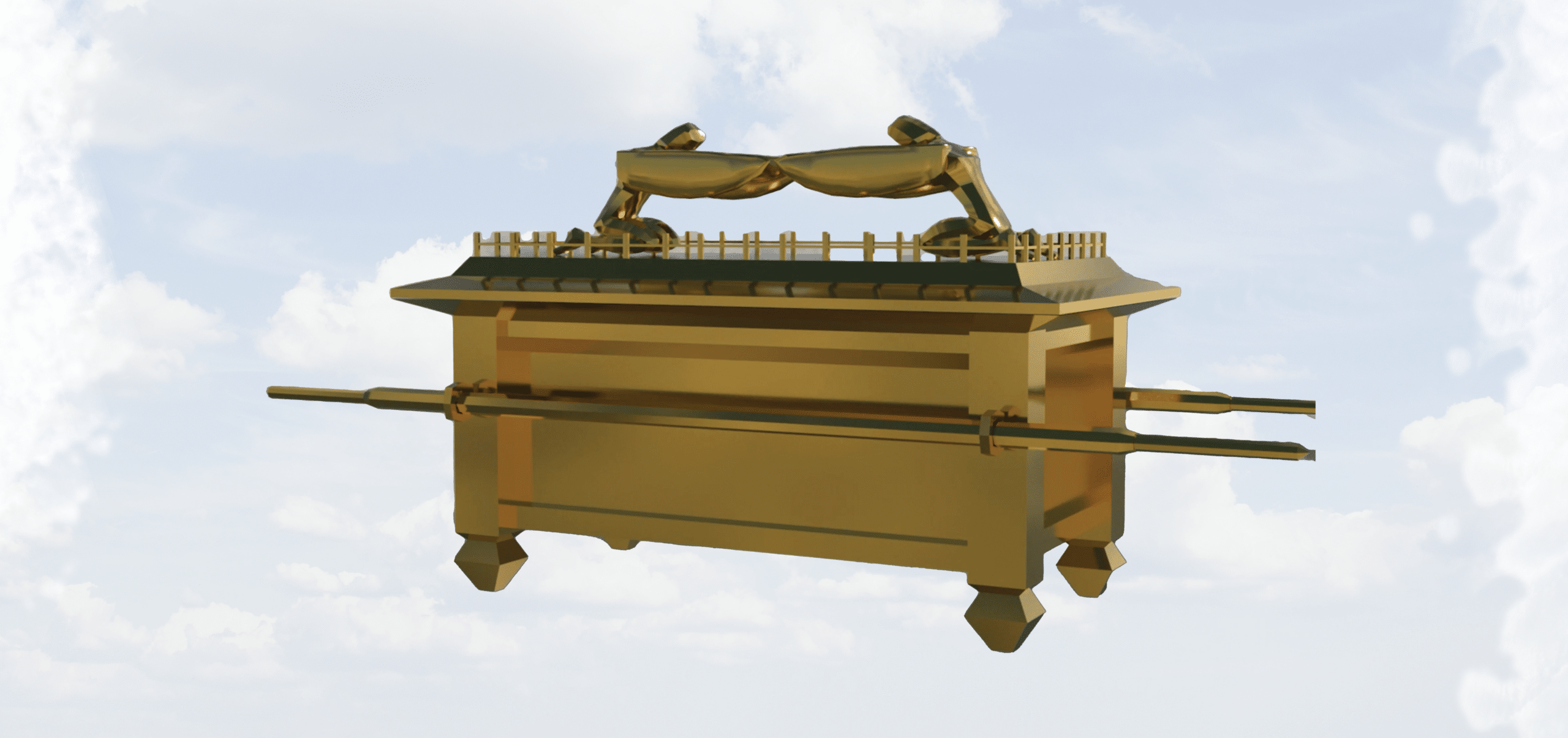Where Is the Ark?

One of the many intriguing and beguilingly romantic things about the Middle East are the numerous stories of hidden treasure, lost cities and secrets beyond the imagination. You have probably heard the stories of Aladdin and his magic lamp, Scheherazade and 1,001 Arabian Nights, and the royal cities of Babylon, Nineveh and Petra lost in the sands of the desert, half as old as the sands of time.
Also, there is the narrative of Sinbad and his search for treasure in secret chambers – revealed by uttering “open sesame,” the lost treasures of King Solomon and his mines and the legendary search for the Holy Grail.
The Bible surpasses all of these intriguing tales of wonder. For in its pages are revealed the most beautiful, ancient and powerful treasure of all, the search for the golden Ark of the Covenant and its accompanying Temple Treasures such as the Ark of the Covenant.
In movies and in reality, the search for the lost Ark of God continues.
The History of the Ark
What is the Ark and why is it so important? The Ark is the most holy of several different vessels that God commanded Moses to build, together with the Tabernacle (an early temple), to fulfill requirements for worship. Made of acacia wood, from the shittah (shittim) tree, this Ark was a box 21/2 cubits long (33/4 feet) by 11/2 cubits wide and high (21/4 feet).
The word “ark” comes from the Latin word arca and it means “a chest, a box meant to hold something important.” The Ark of Noah was designed to be a huge floating boat (shaped similar to an enormous box) meant to hold Noah, his family and the representative animals of each kind in the world before the flood.
The Ark of the Covenant, conversely, would be a medium size box meant to hold the Word of God, represented by the Ten Commandments, the first written scrolls of the first Five books of the Bible (the Torah), Aaron’s rod that budded and a pot of manna. The anointing oil used to anoint the Mishkan (the Tabernacle) and its vessels, and the kings and high priests of Israel was also kept on the side of the ark.
The word ‘Aron is related to Or, meaning light, because the Word of God inside the Ark stood for the light of the world. Since the Ark contained the stone Tablets of the Covenant (the Ten Commandments) and the Torah scroll of Moses, it was called the Ark of the Covenant and symbolized God’s presence and Prophecy in Israel.
Moses received instructions for the Ark when he was given the Ten Commandments’ on Mt. Sinai. The Ark was layered with gold within and without and the exposed rim was also layered with a golden crown bordering the top.
The Jewish Ark was placed into the Jewish house of worship (first the Tabernacle, a portable structure, and later the Jewish Temple in Jerusalem). It was made to serve two purposes. First, the Ark was the throne of God and God’s footstool where He dwelt between the two cherubim in the Shekinah Glory (God represented in a beautiful cloud). The Shekinah (“dwelling, resting”) describes the Divine Presence, the indwelling of God, that was manifested by “dwelling” between the wings of the cherubim above the Ark (1 Chronicles 13:6). It represented the presence of God with the Israelites, first in the Tabernacle and later in the First Temple.
Secondly, during the Day of Atonement, the high priest would offer a special sacrifice for the sins of the entire Israelite nation. He would enter the inner most holy room of the temple and there sprinkle the blood of the sacrifice on the lid. Thus, the lid of the Ark was called the Mercy Seat because it showed the propitiation of sin, appeasing the wrath of God for the sin of the nation.
Wanting to build a permanent Jewish Temple for worship and sacrifice, King Solomon began its construction on Mount Moriah in the fourth year of his reign. The entire Temple was finished in just less than seven years. When complete, the priests put the Ark into the Holy of Holies and drew out the staves. For the Jews, the Ark now had a permanent home. (II Chronicles 5:7-9)
At the destruction of Jerusalem, the Ark was not specifically mentioned, but the following words may be noted: “The King of Babylon … carried out thence all the treasures of the house of Jehovah.” (II Kings 24:13)
When the Temple vessels were returned to Jerusalem and restored to the rebuilt Temple under Zerubbabel, the Ark is not specifically mentioned.
Where is the Ark Now?
Where did the Ark go? Was it hidden and forgotten? Did an earlier king plunder it? When exactly did the Ark disappear and what happened to it? Numerous theories abound as to its disappearance and possible hiding place. Here presented are five of the 25 locations explored in the new book Treasure of the Coming Temple of God.
Jewish scholars differ as to what happened next to the Ark. Some believe that the Ark always remained in the secret chamber under the Temple Mountain. Others maintain that Jeremiah the Prophet was warned by God of the coming Babylonian invasion and the impending destruction of the Temple. The Apocryphal book of Maccabees 2:1-7 records that Jeremiah hid the Ark in a secret sealed cave beneath Mount Nebo on the other side of Jordan. There it remained until the rebuilding of the Temple under Zerubbabel, when it was possibly replaced in the Temple of Jerusalem. But the priests must have removed the Ark again before the Roman invasion of Jerusalem by Pompey in A.D. 63. Like questions, many possibilities abound.
The first possibility usually mentioned is that the Ark was destroyed by Nebuchadnezzar in 597 B.C. or by his general, Nebuzaradan in 586 B.C. (II Kings 24:13; 25:8-21; Jeremiah 39:8-10; 52:12-27)
It has also been suggested that the Ark was destroyed by fire in 586 B.C., when Nebuzaradan eventually trespassed and violated the Temple and set it on fire, as 2 Chronicles 36:19 states that the fire “destroyed all the goodly vessels.”
Is the Ark in Heaven?
Sometimes it is suggested that God took the Ark to heaven where it now resides. This view seems to have originated from traditions of the Catholic Church and have no basis in Scripture. The basis of this view comes from a misunderstanding or misinterpretation of Revelation 11:19 which says:
“And the temple of God was opened in heaven, and there was seen in his temple the Ark of his testament: and there were lightnings, and voices, and thunderings, and an earthquake, and great hail.”
The Ark on Earth is a duplicate of the Ark in heaven, together with the other Tabernacle and Temple vessels. John saw the heavenly Ark that has always existed in the heavenly Temple with God. The Ark viewed in heaven by John the Revelator is the original Ark after which the Ark of Moses was patterned and it is the same heavenly scene that Moses saw many years earlier.
Does the Pope Have the Ark?
J.R. Church stated that he believes the Ark is presently underground in vaults owned by the Vatican. He has also told me, as his booklet was going to press, he had met someone else who told him of seeing the Veil of the Temple or Tabernacle stored in boxes underneath the Vatican in hidden vaults.
Rev. Church met Nelson Canode, a former Benedictine monk in the Catholic Church, who claimed to have seen the container for the Ark. While working at a monastery in Subiaco, Italy, thirty miles east of Rome, the monk told Rev. Church that he was taken to a cavern four stories below ground where he claimed to have seen several containers which held the Ark and other artifacts.
The immense wealth of the Catholic Church is a well-known fact and the Vatican is famous as one of the greatest museums of the world. Not only do they have the priceless art of Michelangelo, Bernini and Raphael, there are 1,400 rooms of Museum pieces on display.
It is certainly conceivable that the Roman church or its sympathizers could have purchased or captured the Ark in earlier times and transported it to the Vatican for safekeeping. It is also known that the Vatican has hidden away many important Christian and historical artifacts from public view in the past.
Is the Ark in England or Ireland?
One of the most fantastic stories told about the ark is sometimes related to British-Israelism, a theological idea that is easily disproved as false. This legend teaches that the Ark was taken to the Irish isles by Ollam Fodhla (or “holy prophet”) and a small band in 584 B.C. The legend relates that the group landed near Ulster, where the descendants of the Tribe of Dan lived [!] The “holy prophet” who had brought the ark was the prophet Jeremiah, who subsequently buried it under a hill known today as Ollam Fodhla Cairn (“Jeremiah’s Cave”).
He also brought the stone that Jacob used as a pillow in Genesis 28:11 when he saw the ladder ascending to heaven with angels ascending and descending. This is claimed to be the coronation stone or the “Stone of Scone” used by the British monarchs since the time of Edward I (or Edward Longshanks). The coronation chair and stone had originally been the throne of Scotland but was taken by this English king almost 1,000 years ago.
This story of the Ark in Ireland or England has no real historical basis and is only another of the peculiar ideas taught in British-Israelism, a theology hostile to the Bible and to the Jewish people.
Will the Real Indiana Jones Please Stand Up?
A former Christian minister, who now denies the deity of Christ and other essential Bible doctrines, claims to have found the cave or series of caves that contain the lost Ark and the Ashes of the Red Heifer. Hailing originally from Texas, Vendyl Jones believes these articles are hidden just slightly north of the area of Ein Gedi and the ruins of Qumran. Vendyl Jones has referred to himself as “Texas Jones,” and makes the fantastic claim that he is the real “Indiana Jones” and that the Indiana Jones of movie fame is a fictitious character based loosely on his own life.
In 1977, Jones began digging in the Judean desert. This was motivated by his belief that he will be the one that finds the Temple treasures and ashes of the red heifer. This belief is curiously based upon his discovery of a 15th-century A.D. woodcut of the red heifer ceremony.
His own translation of the text of this woodcut reads: There is a Gentile, who is not an idol worshiper, a Gentile who believes in the One God, and he will find the ashes … And they will sweep every corner until they have found her.
It is Jones’ contention that he will be that Gentile to find the red heifer ashes. He also has frequently quoted statements by Rabbi Shlomo Goren that Gentiles will assist in the discovery of the Temple vessels and the restoration of the Temple worship. Rabbi Goren based this conclusion upon an interpretation of Zechariah 6:15.
Is the Ark in Qumran by the Dead Sea?
Qumran, odd as it may seem, is also a possible resting place of the lost Ark. Gary Collett, an American minister interested in prophecy and associated with Jerusalem Ministries International, believes that the Ark was taken and hidden there at some point before A.D. 70. Sometimes a date before 56 A.D. is given because an earthquake that year made the city uninhabitable. The famous caves of the Dead Sea Scrolls were probably sealed by the earthquake of that year, sealing with them their contents such as the famous scrolls, and the city was then abandoned.
Is the Ark in Jerusalem?
The most widely held view by Jewish scholars is that the Ark of the Covenant was hidden on the Temple Mount in Jerusalem. It is almost the only view that is ever seriously held by rabbinical scholars.
The Mishnah tells of the Ark being hidden on the Temple Mount and even included a death warning to anyone who told its location. This secret location has been passed down through the centuries to Jewish rabbis but is not generally known to Gentiles.
Could it be under The Dome of the Rock? Was the Ark actually seen by anyone? So many questions remain unanswered, after all these centuries and quests to find the treasures of the last Temple.
Was There More Than One Ark?
One unusual point that must be included here is that there was probably more than one Ark. The Jerusalem Talmud clearly refers to a second Ark of the Covenant.
A second Ark containing the Tablets broken by Moses accompanied the people to war at all times.
The Ark of Moses was possibly hidden in a genizah (a sacred burial or hiding chamber) in the wilderness but seems to have made several appearances throughout Scripture. Exodus 37 tells how the Ark was made of costly materials (much gold and acacia wood) after Moses descended from Mt. Sinai with the second two tables of stone (Exodus 34:29). On the other hand, Deuteronomy 10 tells us Moses himself constructed the Ark of plain shittim wood just before he went up into the mount to receive the second set of two tables of stone. This ark was probably covered in gold, but less ornate.
William R. Arnold mentions the possibility of three or more Arks. He makes some excellent points about the existence of profane arks and the use of ephods in pagan worship.
Soon and Very Soon
Of this we are confident, soon the Ark will be found and the rebuilding of the Temple will occur. We stand at the very threshold of that momentous day. According to ultra-conservative Jewish thought, the discovery of the Ark of the Covenant would be the ultimate factor in forcing Israel to rebuild the Temple. Many times, observers of the Jews who are looking for the Ark and Ashes are impressed and sometimes obsessed with the idea of looking for treasure, such as the gold of the Ark, or additional offerings of coins, and Biblical articles that might be hidden with the Ark. However, for the observant Jews, finding the Ashes of the Red Heifer and the Ark of the Covenant is not just a search for treasure, in the physical sense of riches, but more of a spiritual treasure which enables and opens the door for a soon coming rebuilt Jewish Temple and coming of the Lord and the end of this world as we know it.
[Excerpt from Treasure and the Coming Temple of God]
More from Prophecy in the News Magazine
This site uses Akismet to reduce spam. Learn how your comment data is processed.





Leave a Reply